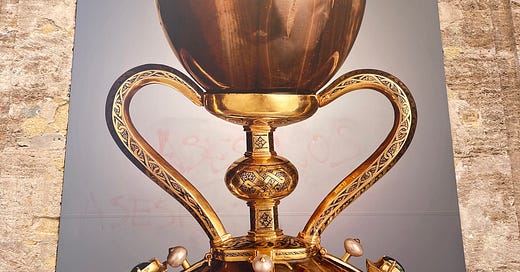Every Wednesday, I share stories of my adventures—whether it's my wanderings in Valencia, a destination I'll forever romanticise, or a book that completely captivated me. Expect tales of fleeting encounters with sharks in Colombia, dancing until dawn in Berlin, and everything in between.
The holy grail allegedly lives in Valencia, after making a long and hazardous journey from Jerusalem to Rome and then to Spain. Today, a chalice sits prettily in Valencia’s beautiful cathedral (La Iglesia Catedral-Basílica Metropolitana de la Asunción de Nuestra Señora de Valencia) and, as I found myself gazing at its polished handles, I couldn’t help but wonder why we are so obsessed with this little brown and gold goblet.
The Valenciano ‘holy grail’ itself — of course legit — is a nice, but small unassuming chalice. If I saw it on the drinks cabinet at a friends house I’m not sure it would be especially noteworthy. Yet, despite its modest grandeur, the concept behind it has inspired countless legends, books, and films. It is intrinsically linked to self-discovery and the secrets of humanity.
So how did it become one of the greatest sources of myth and mystery in the Western World?
Holy Grail History, According to Valencianos
According to popular legend, Jesus is believed to have used the cup at the Last Supper. Some legends say it was later used to collect his blood at the Crucifixion. After BC turned to AD, Saint Peter and other early christians supposedly preserved the chalice in Jerusalem before it was taken to Rome, where successive popes looked after it.
During Emperor Valerian’s persecution of Christians in AD 284, Pope Sixtus II is said to have entrusted the Grail to Saint Lawrence, a Spanish-born deacon, to protect it. Before Lawrence was martyred, he sent the chalice to his homeland in Huesca, Spain for safekeeping.
For centuries, the Grail was reportedly hidden in remote Spanish monasteries, including San Juan de la Peña in Aragón. During the Moorish conquest of Spain (711 AD), the chalice was supposedly safeguarded in various locations.
The first clear historical mention of the chalice appears when King Martin I of Aragon requested it for his palace in Zaragoza, in 1399. A few decades later, King Alfonso V of Aragon flogged the chalice to the Cathedral of Valencia to fund his latest military campaign. Ever since, the chalice has remained in the cathedral and drawn in millions of eagle-eyed visitors.
Experts have dated the Valencian cup to around 100-50 BC, and confirmed it is made of Middle Eastern agate. This makes it at least chronologically plausible as the vessel Jesus could have used. But to me it looked far too ornate, with decorations of pearls and precious stones, to fit with Jesus’s monastic aesthetic preferences. Like Jeremy Corbyn using a Hermès bag to carry his pickles.
How did its legend begin?
The grail only later became linked to the meaning of life and one of humanity’s greatest mysteries. Its earlier legends were more humble.
In first known literary mention of the Grail, Chrétien de Troyes' Perceval, The Story of the Grail (c. 1180), it was not yet the cup of Christ, but rather a mysterious, magical object in the hands of the Fisher King.
Several centuries later, Sir Thomas Malory added King Arthur to the mix. In Le Morte d'Arthur (1485), as Arthur lies dying, he sends his knights off in search of the grail to cure their king and the kingdom. Eventually Sir Galahad, the ‘purest’ knight, achieves the Grail quest (or maybe it’s another knight, depending on the version). Over time, the Grail evolved from a magical vessel to a deeply spiritual object representing divine grace and redemption.
Its importance in popular culture arguably peaked in the late 20th century when Monty Python produced a film satirising the Arthurian legend and man’s absurd quest for the Holy Grail as spiritual enlightenment. In this Sir Galahad gets lured by a suspect grail into Castle Anthrax — home of eight score young blondes and brunettes — and almost ends up ‘the not quite so pure’.
After all their trials, Arthur and his knights finally approach another castle where the Holy Grail is supposedly kept — only to be “taunted a second time” by French soldiers! Then, before they can attack, modern-day police show up and shut the whole thing down.
After visiting the Holy Grail in Valencia’s Cathedral, I do think the Monty Python guys represented it the most accurately. Python’s film is all about taking a ridiculous premise and treating it with completely unwarranted seriousness, like the knights debating whether a swallow — be it African or European — could carry two halves of a coconut tied together using a bit of creeper.
The Holy Grail is a great plot device, but its legend is absolutely absurd and importance entirely spun out of control. The cathedral itself is worth visiting, and historically monumental in its own right, but the Holy Grail is far more compelling as an elusive legend.
Love my writing? Hit the heart button or buy me a coffee






